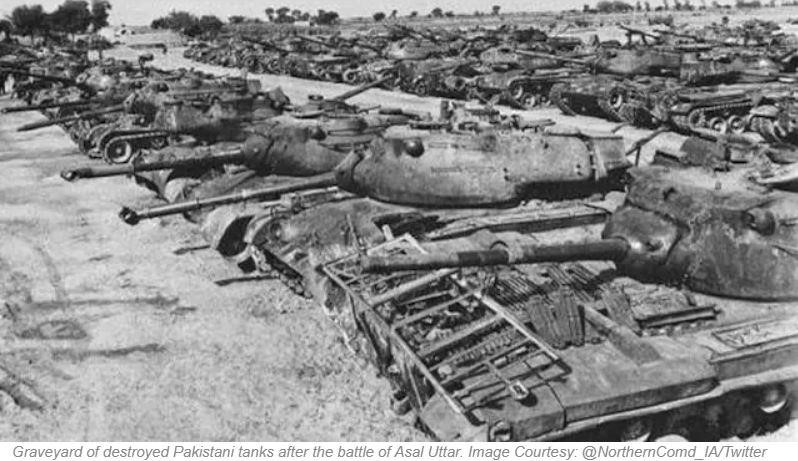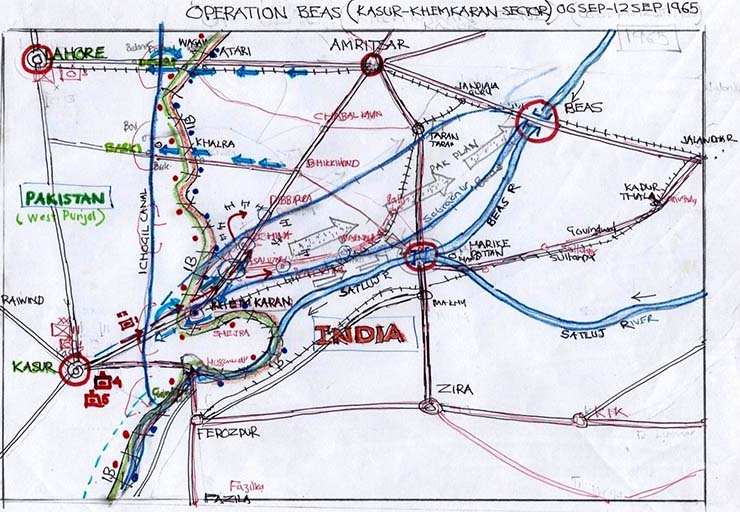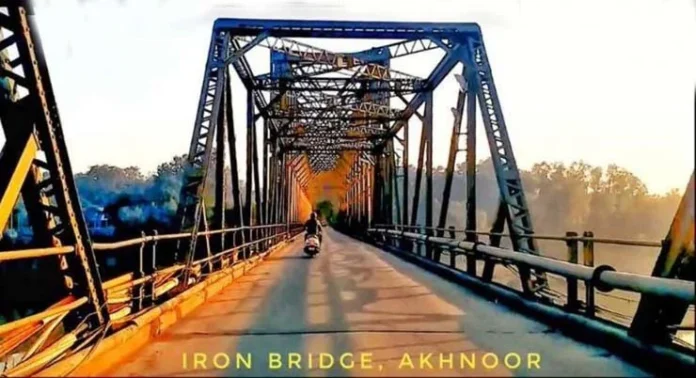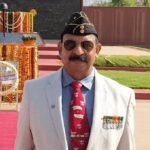Pakistan launched Operation Grand Slam on 1 September 1965 and crossed the ceasefire line north of Chenab River between Pir Jamal village and Burejal spearheaded by 2 Armoured Regiments and two brigades and were leaning on Munawar Tawi in Chamb Area of Jammu by 2 September. The main objective was to capture the strategic Akhnoor Bridge on River Chenab and cut off the Jammu-Rajouri-Poonch highway. Pak troops reached Jaurian on the last light of 4 September and were just 18 km from Akhnoor. Reading the critical situation, Lt Gen Harbaksh Singh, Western Army Commander, approached General J N Choudhary, COAS, to get clearance from the PM to open the western front in Punjab. President Ayub Khan writes in his biography, “That was the tallest decision by short PM Lal Bahadur Shastri, which turned the course of 1965 War.”
Regarding India’s decision to open the western front in Punjab, Pakistan’s President Ayub Khan wrote in his biography, “That was the tallest decision by short PM Lal Bahadur Shastri, which turned the course of 1965 War.”
Operation Riddle was launched by Indian forces from 11 Corps Zone on 6 September 1965 to relieve pressure on the Chamb-Jaurian Sector. The three-prong offensive was launched in Lahore axis, Khalra axis and Kasur axis by 15, 7 and 4 Infantry/Mountain Divisions. Initial objectives were to capture the area up to Ichogil Canal in the entire sector and capture bridges on the canal at Dograi, Barki and Gandasinghwala in a swift move. 2 (I) Armoured Brigade was corps reserve at Taran Taran. 3 Cavalry equipped with Centurions was shifted from 1 Armoured division to give punch to 2 Indian Armoured Brigade. 8 Cavalry and Deccan Horse were other units in the sector. 15 Infantry Division with two brigades (38 and 54) advanced rapidly on the Amritsar Lahore axis with 14 Horse leading on the Grand Trunk Road (NH 1). Dograi Bridge was captured by 3 JAT under daring CO Lt Col Desmond Hyades and they went across at Batanagar, just 5 km from Lahore, but lost communication. Due to heavy shelling and no orders, 3 JAT reverted back to the east of the canal.
Meanwhile, PAF bombarded the B vehicle logistics convoys carrying Ammunition, Fuel and Rations travelling on GT Road. Division Headquarters was also hit. Maj General Niranjan Prashad (15 Div commander) was in shock and did not know the progress of the operation. The offensive was stalled. 7 Infantry division (48 and 65 Brigades) supported by Central India Horse (CIH) also progressed well and captured Barki Police Station after a tough battle on Ichogil. 4 Mountain division (7 and 62 Brigades) with Deccan Horse was to have a firm base at Khemkaran and proceed on Kasur axis and destroy bridge on Ichogil to stall any Pak offensive from Kasur side.

The presence of Pakistan 1 Armoured Division and the new 11 Infantry Division at the Kasur sector was the masterstroke of Pakistan. A new 6 Armoured division was raised and kept at Pasrur to support the Pak I Corps and secretly 1 Armoured Division had been placed at Changa Manga forest near Kasur to launch an offensive at Khemkaran–Beas axis. The advance to the Ichogil Canal was heavily contested and the units of the 7 Brigade abandoned the advance and suffered reversals. The 4 Division commander asked the Corps for permission to withdraw to Asal Uttar and Bhikkiwind area. The Army commander visited there to boost morale and gave permission to withdraw to Asal Uttar on 6 September. The 4 Division finally took defences at Asal Uttar with 4 Grenadiers at Chima, 1/9 Gorkha Rifles at Bhikkiwind, 18 Raj Rifles on the Asal Uttar–Patti axis, 9 JAK Rifles on the same axis in depth on 7 September. Anti-tank Mines were hastily laid. The gap south of Valtoha was flooded with local canals by deliberate breaching.
The ambitious and daring plan of the Pak I Armoured Division was to capture the Beas bridge on the Amritsar–Jalandhar road by advancing one combat group along the road Valthoa–Patti–Raya-Beas bridge and one combat group to advance on Khemkaran-Bhikkiwind–Taran Taran-Jandiala guru to cut GT Road and third Combat group to advance on Northern flank towards Khalra side. The objective was Harike Barrage by 1430 h D day and Beas Bridge by last light D plus 1. With a formidable Armoured division, with three armoured brigades, it was a great plan. The 4 Mountain Divisions were now redeployed with new vigour and determination. On 8 September at 1000h, a probing mission was launched by the enemy with a squadron of Pattons and two squadrons of Chaffee tanks. The Deccan Horse tanks were deployed in pre-reconnoitred locations and in a firefight destroyed Pak 14 tanks. The 2 Armoured Brigade released 3 Cavalry to the Bhkkiwind area and 8 Cavalry moved to the Valthoa area. 1/ 9 GR defended area was overrun by Pak 4 Armd bde at 1430 hours and moved to outflank Grenadiers. 3 Cavalry squadron and 4 Grenadiers intercepted the outflanking manoeuvre. The situation at 0800 h on 9 September was that Asal Uttar on road Khemkaran-Bhikkiwind was strongly held by 3 battalions, with a squadron of Shermans of Deccan Horse. Another DH Squadron was in the Gun area in depth. 3 Cavalry (minus) was in the gen area Dibbipura-Chima. 8 Cavalry one squadron was east of Valthoa and 8 Cav minus 1 was at Warnala 10 km further east. On 9 Sept, enemy armour tried to bypass from the south but most of the tanks were bogged down in the flooded area and were sitting ducks for 8 cav and 3 cav. The attempt was aborted.
Pakistan again launched Patton in a night attack with a combat group on 18 Raj Rifles at Asal Uttar. Heavy Artillery fire blunted the attack. There was no breakthrough from fort-like defences at Asal Uttar. The frustrated GOC now ordered to break through from the northern flank on 10 September with reserve Armoured bde at 0700 h on 10 September. A column headed for Chima where 4 Grenadiers were ready with RCLs and MMGs to face them. B squadron of 3 Cavalry was ready in ambush in sugarcane fields. As the Pattons came in range broadside, Centurions played merry hell on code word ‘Maro’. Ten pattons were hit and started burning. The enemy further outflanked and headed for Dibbipura – Mahmudpura. 3 Cavalry with two squadrons were ready for the masterstroke. Enemy tanks were now struck in a horse shoe getting slaughtered from 3 sides. Dibbipura-Chima became the Waterloo for the Pak 1 Armoured division. The number of Pattons were shot and many got bogged down in wet fields. 4 Division which was in near collapse in the initial days, fought back like a wounded tiger and with depleted strength and with the support of 2 Armoured Brigade inflicted crushing defeat on 1 Armoured Division “the Pride of Pak‘ equipped with 3 Armd bde, 4 Armd bde and 5 Armd bde.

At 1430 h on same day, Major General Nasir Ahmed, General officer Commanding, I Armoured Division, decided to get down in frustration, from a helicopter and rushed in Jeep along with Arty brigade commander, Brigadier A R Shammi from Khemkaran to Bhikkiwind. At km 38, the Rover group was hit by Arty fire and fire from 4 Grenadiers defences. The leading Jeep overturned. Maj General Nasir Khan was severely injured but was evacuated but Brig A R Shammi was killed. His body was later discovered and buried near Chima village with military honours. CQMH Abdul Hamid of 4 Grenadier knocked down 4 Pattons with his 106mm Jeep mounted Recoilless Gun in the same area and was awarded Paramvir Chakra posthumously for his daring action.
Pakistan lost/abandoned 100-plus tanks in the general area Valthoa-Asal Uttar- Chima triangle. After the ceasefire, all Patton tanks were collected at Bhikkiwind, which was called by locals the graveyard of Patton. National media nicknamed the area as Patton Nagar. On 11 September, 12 officers and about 80 troops of 4 Cavalry surrendered. Our losses were one Centurion and 4 Sherman tanks in the famous battle of Asal Uttar. It was a decisive battle which changed the course of the war as the Pak 1 Armoured division was completely annihilated but Khemkaran Village could not be taken back before the ceasefire. The myth of the invincible American Patton Tank was broken. Pakistan approached the UN for the ceasefire due to an adverse situation. India announced the ceasefire on 23 September 1965. Ayub Khan’s dream was shattered. Tashkent agreement was signed on January 10, 1966, between two heads of state mediated by the Soviet Union. India returned all occupied territory including strategic Haji Pir Pass. The biggest loss to India of the 1965 War was the demise of Indian PM Lal Bahadur Shastri, who died under mysterious circumstances in the early hours of 11 January 1966 at Tashkent, now in Uzbekistan. Thus, Operation Riddle, the bold decision to open launch an offensive in Punjab, saved Jammu-Kashmir. 3 Cavalary was bestowed with the title of “Patton Wreckers”.
-The writer is an Indian Army veteran and a defence analyst. He has keen interest in Geo-strategic affairs and writes regularly on internal and external affairs issues related to India and neighbours. The views expressed are personal and do not necessarily reflect the views of Raksha Anirveda
-The writer is an Indian Army veteran and a defence analyst. He has keen interest in Geo-strategic affairs and writes regularly on internal and external affairs issues related to India and neighbours. The views expressed are personal and do not necessarily reflect the views of Raksha Anirveda














